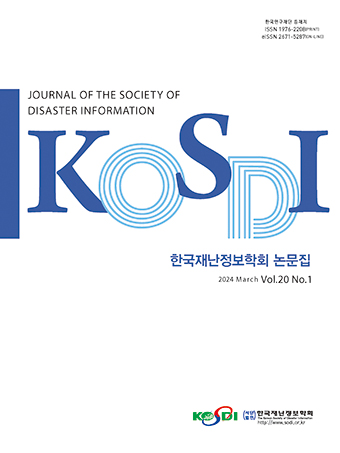Original Article
Abstract
References
Information
Purpose: In response to the critical risk of fire due to the characteristic of Publicly used establishments(hereinafter referred to as PUE), ‘Special Act on the Safety Control of PUE’ was enacted in 2006 and is still in operation. However, in spite of numerous revisions so far, still there are problems to be resolved. This study analyses the regulatory regime of fire safety in UK to find measures which could fundamentally improve the safety management of PUE. Method: This study compares and analyses the safety management system of PUE in Korea and the case of the UK by using the comparative research method. Result: As a result of the qualitative analysis, some noticeable systems and concepts of the UK regulatory regime have been discovered(e.g. ‘Responsible person’, ‘Fire risk assessment’, ‘Fire safety audit’, etc.) and consequently, ‘Proposal for the Fire Safety Management System for PUE’ is designed based on the findings from examples in the UK and drawbacks of safety management of PUE. Conclusion: This study proposes the way to improve the safety management of PUE into a more rational and effective system by analysing the case of the UK, which reorganised the fire safety management to the private sector centered, in which the fire authority minimizes intervention.
연구목적: 국내 다중이용업소는 업종의 특수성 등으로 인하여 화재위험성이 높은 것으로 평가되며, 이에 따라 2006년에 다중이용업소의 안전관리에 관한 특별법이 제정되어 현재까지 운용 중이나 그간 다수의 개정에도 불구하고 개선할 점이 여전히 상존한다. 본 연구는 규제체계의 구축과 운영에 있어 모범국가인 영국의 안전규제체계를 분석함으로써 국내의 다중이용업소 안전관리체계를 근본적으로 개선할 수 있는 방안을 마련하고자 하는 취지에서 수행되었다. 연구방법: 본 연구는 비교연구법을 활용하여 국내 다중이용업소의 안전관리체계와 영국의 화재안전 관리체계를 분석하였다. 연구결과: 이러한 정성적 분석의 결과, “관계인”, “화재위험평가”, “화재안전감사” 등 국내 다중이용업소의 안전관리체계를 개선하기 위해 주목할 만한 제도들을 선정하였고, 이에 추가로 국내의 제반여건을 고려하여 “국내 다중이용업소 소방안전관리체계(案)”를 고안하였다. 결론: 본 연구는 다중이용업소의 안전체계를 민간 중심으로 재편하고 특히 화재예방분야에서 정부의 개입을 최소화하는 영국의 사례를 분석함으로써 앞으로 국내의 다중이용업소 안전관리체계를 보다 합리적이고 실효성있는 체계로 개선시킬 수 있는 방안을 제안한다.
- Act on Fire Prevention and Installation, Maintenance, and Safety Control of Fire-Fighting Systems. 2020.6.9., National Fire Agency, Korea.
- ALARP information:Health and Safety Executives, https://www.hse.gov.uk/comah/alarp.htm (Date of Access: 2020.10.22.)
- BAFE Fire Safety Register, https://www.bafe.org.uk/ (Date of Access: 2020.10.22.)
- Better Regulation Task Force (2005). Regulation - Less is More: Reducing Burdens, Improving Outcomes. Department for Business, Enterprise and Regulatory Reform, London, UK.
- Chief Fire Officers Association (2015). Fire Safety Guidance Notes and Audit: Version 4.3. CFOA Publications Ltd., Pebble Close, UK.
- DCLG (2018). Fire safety risk assessment: small and medium places of assembly. DCLG: UK Government, London, UK.
- Enforcement Decree of the Special Act on the Safety Control of Publicly Used Establishments. 2019.7.3., National Fire Agency, Korea.
- Enforcement Rule of the Special Act on the Safety Control of Publicly Used Establishments. 2019.4.22., National Fire Agency, Korea.
- Fire Prevention Division: NFA (2008). 2020 Fire Prevention Stastics Data. National Fire Agency, Korea.
- Fire Risk Assessors and Auditors: The Institution of Fire Engineers, https://www.ife.org.uk/Fire-Risk (Date of Access: 2020.10.22.)
- Fire Safety Advice Center, https://www.firesafe.org.uk/fire-risk-assessment/ (Date of Access: 2020.10.22.)
- Fire safety in the workplace: GOV.UK, https://www.gov.uk/workplace-fire-safety-your-responsibilities (Date of Access: 2020.10.22.)
- Fire safety law explained: LFB, https://www.london-fire.gov.uk/safety/the-workplace/fire-safety-law-explained/ (Date of Access: 2020.10.22.)
- Fire statistics data table: GOV.UK, https://www.gov.uk/government/statistical-data-sets/fire-statistics-data-tables #fire-prevention-and-protection (Date of Access: 2020.11.16.)
- Hampton, P. (2005). Reducing Administrative Burdens: Effective Inspection and Enforcement. HM Treasury, London, UK.
- Hackitt, J. (2018). Building a Safer Future: Independent Review of Building Regulations and Fire Safety: Final Report. HM Stationery Office: UK Government, Cm 9607, London, UK.
- HM Treasury (2007). Public Expenditure Statistical Analyses 2007. The Stationery Office, Cm 7091, London, UK.
- HM Treasury (2011). Public Expenditure Statistical Analyses 2011. The Stationery Office, Cm 8104, London, UK.
- Hills, R. (2018). Rebuilding Confidence: An Action Plan for Building Regulatory Reform. Building Products Innovation Council, Australia.
- Kim, D. (2005). Study on the Fire Safety of Entertainment Service Buildings. MEng. Dissertation, Hoseo University.
- Lee, S. (2009). Viable Fire-countermeasures for Majority-used Buildings' Fire Fighting Safety. MEng. Dissertation, Dongsin University.
- May, P.J. (2003). "Performance-based regulation and regulatory regimes: The saga of leaky buildings." Law & policy, Vol. 25, No. 4, pp. 381-401. 10.1111/j.0265-8240.2003.00155.x
- Meacham, B.J. (2010) Performance-Based Building Regulatory Systems: Principles and Experiences. Inter-jurisdiction Regulatory Collaboration Committee, Australia.
- Special Act on the Safety Control of Publicly Used Establishments. 2020.3.24., Korea.
- Publisher :The Korean Society of Disaster Information
- Publisher(Ko) :한국재난정보학회
- Journal Title :Journal of the Society of Disaster Information
- Journal Title(Ko) :한국재난정보학회논문집
- Volume : 16
- No :4
- Pages :768-783
- DOI :https://doi.org/10.15683/kosdi.2020.12.31.768




 Journal of the Society of Disaster Information
Journal of the Society of Disaster Information







